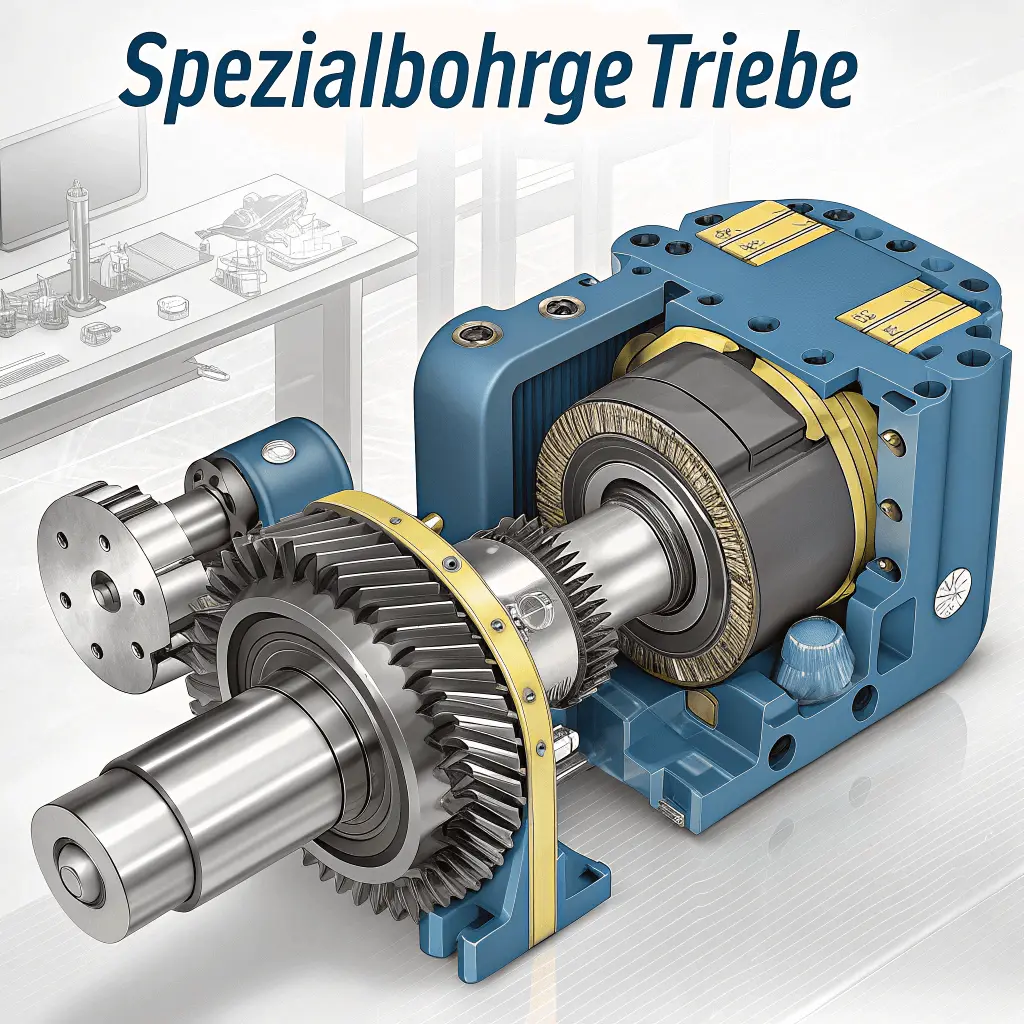The term Spezialbohrgetriebe refers to a highly specialized type of gearbox specifically designed for complex and high-demand drilling operations. These gearboxes play a critical role in industrial applications where standard gear systems fall short. Whether it’s for drilling into solid rock, operating multiple drills simultaneously, or ensuring extreme precision, a Spezialbohrgetriebe is engineered to deliver optimal performance.
In this comprehensive guide, we’ll explore what makes the Spezialbohrgetriebe so essential, how it functions, where it’s used, the benefits it provides, and what to consider when choosing one. This article will also highlight future innovations and answer the most frequently asked questions.
What Is a Spezialbohrgetriebe?
A Spezialbohrgetriebe, or specialized drilling gearbox, is a custom-engineered transmission system developed to meet the unique demands of drilling machines. Unlike standard gearboxes used in general machinery, these are tailored to perform in extreme environments, provide high torque output, and maintain precise control over drilling speed and power.
These gearboxes are not mass-produced. Instead, they are developed on a case-by-case basis to ensure compatibility with a specific application. The customization process often involves choosing between different gear types like spur gears, planetary gears, or worm gears, depending on the desired torque, speed, and durability.
Key Functions and Operating Principle of a Spezialbohrgetriebe
At the heart of every Spezialbohrgetriebe is the purpose of converting motor rotation into optimal torque and speed for drilling. This transmission adapts the motor’s output to match the precise drilling requirements, which might include slow-speed drilling with high torque or high-speed drilling with moderate force.
How It Works:
- Motor Input: The motor provides the initial rotational energy.
- Gear Mechanism: Gears adjust the speed and torque of that energy.
- Drill Output: The adjusted output is transferred to the drill, enabling it to penetrate materials efficiently.
The gearbox typically includes:
- Input Shaft: Connects to the motor.
- Gear Assembly: Adjusts torque and speed.
- Output Shaft: Delivers force to the drill tool.
This internal gearing is often made from hardened steel or other robust materials to resist extreme loads, heat, and friction.
Why Industries Rely on Spezialbohrgetriebe
In industries like mining, construction, oil exploration, and tunnel boring, machines often encounter tough working conditions. The demand for accuracy, strength, and reliability is immense. That’s where Spezialbohrgetriebe comes in.
Common Reasons for Usage:
- Customized Torque and Speed: Adaptable to any material hardness or drilling depth.
- Multiple Drill Synchronization: Power several drill heads at once.
- Operation in Harsh Environments: Performs under pressure, heat, and vibration.
- Minimal Downtime: Built for endurance and low maintenance.
Applications of Spezialbohrgetriebe in Industry
Spezialbohrgetriebe are used in a wide range of industrial drilling environments where standard gearboxes would not perform adequately.
1. Tunnel Boring Machines (TBMs)
Used in massive machines that bore through rock and soil, requiring millions of Newton-meters of torque. Companies like ZOLLERN specialize in such high-performance applications.
2. Geothermal and Oil Drilling
The gearbox helps maintain controlled torque and stability while drilling deep underground or offshore.
3. Precision CNC Machinery
In metalworking and manufacturing, specialized gearboxes provide pinpoint drilling accuracy and can power multiple drilling units simultaneously.
4. Mineral Extraction
Environments where materials are extremely hard or variable in density, necessitating robust and adaptable gear systems.
Components of a Spezialbohrgetriebe: Explained
Understanding the inner components of these gearboxes helps clarify why they are so effective:
| Component | Function |
|---|---|
| Gearbox Housing | Encases the entire system and protects from external factors |
| Input Shaft | Receives power from the motor and initiates motion |
| Output Shaft | Transfers modified torque/speed to the drill |
| Spur Gears | Simple gears offering direct power transmission |
| Planetary Gears | Compact systems that provide high torque in limited space |
| Worm Gears | Allow slow, high-torque output with self-locking features |
Advantages of Spezialbohrgetriebe in Drilling Operations
The benefits of using Spezialbohrgetriebe go far beyond mere customization. They directly contribute to performance enhancement, cost reduction, and safety.
1. High Torque Performance
Capable of handling extremely high loads, these gearboxes ensure effective drilling in materials such as granite, basalt, or dense soil.
2. Longevity and Durability
Thanks to their high-quality materials and precision engineering, these gearboxes have a long operational life and reduced maintenance needs.
3. Precision Control
Essential in applications where even minor drilling errors can be costly or dangerous, such as aerospace or underground infrastructure.
4. Cost Savings
Reduced wear, less downtime, and fewer replacements translate into lower lifetime operational costs.
5. Versatility
From horizontal boring to vertical shaft drilling, these gearboxes are designed for multi-directional adaptability.
How Spezialbohrgetriebe Are Designed and Manufactured
Creating a Spezialbohrgetriebe involves multiple stages, from understanding client needs to final testing.
Step-by-Step Process:
- Requirement Analysis: Define speed, torque, load, and environmental conditions.
- Design and Engineering: CAD models and simulations are used to optimize gear arrangement.
- Material Selection: Based on wear resistance, load-bearing, and operational heat levels.
- Precision Manufacturing: Gears are machined under ISO 9001-certified processes.
- Assembly and Testing: Every unit is rigorously tested before dispatch.
- Maintenance and Support: Some manufacturers provide lifetime support and upgrades.
Leading manufacturers include Siggemann GmbH, RSGetriebe, Rehfuss Drive Solutions, and Ruhrgetriebe, all of which offer tailored solutions based on client needs.
Key Considerations When Choosing a Spezialbohrgetriebe
Before investing in a specialized gearbox, there are several critical factors to evaluate:
1. Torque Requirements
Choose a gearbox that meets or exceeds the maximum load torque expected during operation.
2. Gear Ratio
Impacts the balance between speed and force — vital for adapting to different materials.
3. Environmental Conditions
Gearboxes exposed to dust, water, chemicals, or temperature extremes need specific sealing and materials.
4. Size and Space Constraints
The gearbox must fit within the mechanical limits of the existing drilling system.
5. Integration Compatibility
Ensure seamless interfacing with current motors, drives, and mounts.
6. Supplier Support
Opt for a manufacturer with strong after-sales service, documentation, and customization capability.
Innovations and Future Trends in Spezialbohrgetriebe Technology
The future of drilling gearboxes is evolving rapidly thanks to digitalization, automation, and smart materials.
1. Automation Integration
Modern Spezialbohrgetriebe systems now support automated torque adjustments and drill positioning, reducing operator intervention.
2. IoT and Real-Time Monitoring
By using sensors, these gearboxes can monitor temperature, vibration, and performance, allowing predictive maintenance and reduced failures.
3. Advanced Materials
Use of lightweight composites and heat-resistant alloys increases efficiency and reduces wear.
4. Sustainability and Energy Efficiency
Modern designs aim to reduce energy loss and extend operating life, making them more eco-friendly.
Frequently Asked Questions (FAQs)
1. What does “Spezialbohrgetriebe” mean in English?
It translates to “special drilling gearbox,” referring to a custom-built gear system for advanced drilling applications.
2. How is a Spezialbohrgetriebe different from a standard gearbox?
Standard gearboxes are generic and mass-produced. A Spezialbohrgetriebe is customized to meet specific torque, speed, and environmental needs.
3. Can it be used in offshore drilling?
Yes, especially when designed with corrosion-resistant materials and seals for underwater environments.
4. Are these gearboxes maintenance-intensive?
No. They are built for durability and low maintenance, but periodic inspections are essential.
5. What industries commonly use Spezialbohrgetriebe?
Mining, tunnel construction, oil & gas, geothermal drilling, CNC machining, and infrastructure development.
6. What types of gears are used?
Common types include spur gears, planetary systems, and worm gears, chosen based on torque and space requirements.
7. Can I retrofit an existing machine with a Spezialbohrgetriebe?
Yes, but it requires precise customization and engineering alignment with the existing setup.
8. Do these gearboxes come with automation features?
Many modern designs now include automated control and remote monitoring capabilities.
9. What is the average lifespan?
With proper use and maintenance, a Spezialbohrgetriebe can last 15–25 years or more.
10. Who are some leading manufacturers?
Notable companies include Siggemann GmbH, RSGetriebe, ZOLLERN, and Rehfuss Drive Solutions.
Conclusion
The Spezialbohrgetriebe has become a cornerstone of modern drilling technology due to its versatility, reliability, and performance. From precision machining to underground tunnel construction, these specialized gearboxes ensure that drilling operations are carried out with maximum efficiency and minimal risk.
Choosing the right Spezialbohrgetriebe is not just a technical decision but a strategic one. It can mean the difference between costly downtime and seamless operation. With continuous innovation driving the field, the future of these gearboxes looks more promising than ever.
For any industry where drilling precision, force, and endurance are crucial, investing in a well-designed Spezialbohrgetriebe is not just beneficial — it’s essential.

